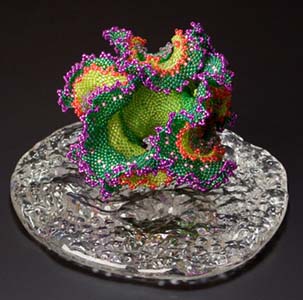| Artists' List | Exhibits | Mostly Glass' Home Page | Ordering | Contact |
|
|
The Art
of Weaving Glass Beads Spring, 2008 |
Exhibit's Main Page |
|
Beads are found in most cultures around the world and have been used in multiple ways as forms of body adornment, talismans, and sacred objects. They also were also used to convey important information such as a person’s social rank, marital status, age and group origin. Each culture has contributed unique examples of beadwork that utilize a variety of beading techniques of unknown origins. Most experts agree that beadwork is primarily a textile art involving needle and thread, though there are several other ways of uniting beads that do not involve thread at all. Great centers of glass seed bead manufacturing grew up in Europe, China, and India. The Venetians began making glass beads around 1200, and by the eighteenth century had a near-monopoly on the glass bead market. However, additional centers of bead manufacturing developed in other parts of Europe, including Bohemia and Moravia (now the Czech Republic), France, Germany and Holland. These beads became prime trade items and were distributed throughout the established seafaring trade routes. Thus, glass beads were introduced to Africa, Asia, the Pacific and North and South America, and Native peoples in these continents absorbed and welcomed these new trade items into their cultural traditions.
Glass seed beads
are traditionally
manufactured using two primary methods. The second method dates from antiquity and involves winding molten glass multiple times around a coated mandrel of metal. Some seed beads from India and China are still being produced using this method. Contemporary lamp-worked beads could be considered as large scale examples of this method.
In the 1980’s computer control of seed bead
manufacturing came into play, both in the Czech
Republic and in Japan.
The Japanese, having the luxury of starting from
scratch, were able to design a computer controlled
extruding process capable of continuously producing
very accurate diameters and hole sizes. These beads
are being made in a variety of shapes, the most
popular being cylindrical, and have large holes that
make beading with them a delight.
Bead weaving techniques
fall into two basic categories.
Bead artists are often self-taught in these
techniques and then go on to develop their own
variations or combinations thereof.
In The Art of Weaving Glass Beads exhibit, we find examples of both categories of bead
weaving as well as bead crochet.
Most of the other bead artists in this exhibit use
off-loom bead weaving. Madelyn Ricks works exclusively in peyote stitch using Japanese Delica seed beads for her very popular Kimono series, her whimsical sculptures, and her Jewelry. For the kimonos, she first graphs her designs by hand, gluing multiple sheets together, then beads it in separate strips which are stitched together.
Sharmini Wirasekara
creates Robes and Wall hanging Objects predominantly
inspired by Mexican Art. For the Robes, she works
in peyote stitch, using Japanese Delica seed beads.
Some of her Wall Objects are Neckpieces.
Mary Darwall
creates sculptural jewelry inspired by sea life and
other natural forms. She combines several techniques
in her jewelry that include free-form
three-dimensional peyote stitch, branch fringing and
appliqué.
Hildegund Ilkerl
and Gabriele Malek are Austrian art teachers,
friends and business partners. They create their
neckpieces, ranging from the whimsical to the very
elegant, using the old bead crochet technique which
had been revived in recent years. Czech seed beads
and Delica beads are used by both artists. All the bead artists in this exhibit are drawn to working with beads because of shared passion for these little tiny bits of colored glass that come in such an enormous variety of colors, shapes, textures and surface finishes. We work with a color palette that is almost infinite in its potential. Each of us appreciates the meditative process weaving for hours and hours our creations to completion, using needle and thread and many thousands of small glass beads. The labor involved is almost incalculable, and when each piece is completed, it has truly become a labor of love, passion and delight.
Wendy Ellsworth |
||
